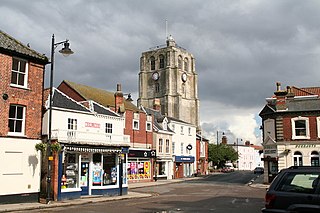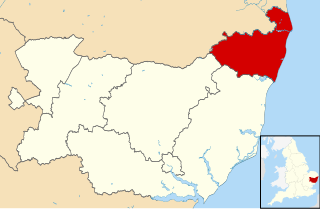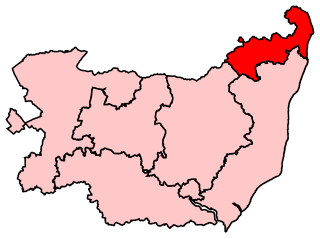This page is based on this
Wikipedia article Text is available under the
CC BY-SA 4.0 license; additional terms may apply.
Images, videos and audio are available under their respective licenses.

Beccles is a market town and civil parish in the English county of Suffolk. The town is shown on the milestone as 109 miles (175 km) from London via the A145 and A12 roads, 98 miles (158 km) northeast of London as the crow flies, 16 miles (26 km) southeast of Norwich, and 33 miles (53 km) north northeast of the county town of Ipswich. Nearby towns include Lowestoft to the east and Great Yarmouth to the northeast. The town lies on the River Waveney on the edge of The Broads National Park.

Lowestoft is an English town and civil parish in the county of Suffolk. The town, on the North Sea coast, is the most easterly settlement of the United Kingdom. It is 110 miles (177 km) north-east of London, 38 miles (61 km) north-east of Ipswich and 22 miles (35 km) south-east of Norwich. It lies on the edge of The Broads system and is the major settlement in the district of East Suffolk, with a population of 71,010 in 2011. Some of the earliest evidence of settlement in Britain has been found here. As a port town it developed out of the fishing industry and as a traditional seaside resort. It has wide, sandy beaches, two piers and other attractions. While its fisheries have declined, oil and gas exploitation in the southern North Sea in the 1960s added to its development, as a base for the industry alongside nearby Great Yarmouth. This role has declined, but the town has begun to develop as an Eastern England centre of the renewable energy industry.
Lothingland is an area in the English counties of Suffolk and Norfolk on the North Sea coast. It is bound by the River Yare and Breydon Water to the north, the River Waveney to the west and Oulton Broad to the south, and includes the parts of Lowestoft north of Lake Lothing.

Brockdish is a village and civil parish in the South Norfolk district of Norfolk, England. It is 3.53 square miles (910 ha) in size. According to the 2001 census the parish had a population of 605 in 265 households, the population increasing at the 2011 Census to 681. The village is situated on the River Waveney, and is about 3 miles (5 km) south-west of Harleston. Like many villages Brockdish has suffered some demise in local business as people work further afield and the bypassing of the village in 1996. The village's second pub shut in 2000 leaving one popular pub in the shape of the Old King's Head; the village hall; village school although rated outstanding by Ofsted closed in July 2016 due to low pupil numbers. The school is now being given a new lease of life as the Waveney Heritage Centre by the Waveney Heritage Community Interest Company; stalls selling fresh eggs, vegetables, plants and a small antiques shop.
Since its inception, the Royal National Lifeboat Institution (RNLI) has provided lifeboats to lifeboat stations in the United Kingdom and Ireland.

The Waveney Valley line was a branch line running from Tivetshall in Norfolk to Beccles in Suffolk connecting the Great Eastern Main Line at Tivetshall with the East Suffolk line at Beccles. It provided services to Norwich, Great Yarmouth, Lowestoft, Ipswich and many other smaller towns in Suffolk with additional services to London. It was named after the River Waveney which follows a similar route.

HMS Waveney was a Hawthorn Leslie-type River-class destroyer ordered by the Royal Navy under the 1902–1903 Naval Estimates. Named after the River Waveney in eastern England, she was the first ship of the Royal Navy to carry this name.

HMS Doon was a Hawthorn Leslie type River-class destroyer ordered by the Royal Navy under the 1903 – 1904 Naval Estimates. Named after the River Doon in western Scotland, she was the first ship to carry this name in the Royal Navy.

The Caister lifeboat disaster of 13 November 1901 occurred off the coast of Caister-on-Sea, Norfolk, England. It took place during what became known as the "Great Storm", which caused havoc down the east coasts of England and Scotland.

The Port of Lowestoft is a harbour in Lowestoft in the English county of Suffolk owned by Associated British Ports. It is the most easterly harbour in the United Kingdom and has direct sea access to the North Sea. The harbour is made up of two sections divided by a bascule bridge. The inner harbour is formed by Lake Lothing whilst the outer harbour is constructed from breakwaters.

Shipmeadow is a small village and civil parish located on the Beccles to Bungay road, in the Waveney district, in the county of Suffolk. Shipmeadow has no shop or even a church because it was made redundant in 1980. Of the village's 140 population, 69 are male and 71 are female according to the 2011 Census. Norwich is located approximately 14.9 miles (24.1 km) NW of Shipmeadow as the crow flies and Great Yarmouth is located 13.7 miles (22.1 km) NE of the village. The River Waveney runs to the North of the village and feeds into the River Yare to the East. 'The White house' and the River Waveney define the North and Western boundaries of the settlement while the boundary to the South is the area between Shipmeadow Common and Hawthorne Farm.

The Waveney-class lifeboat was the first class of lifeboats operated by the Royal National Lifeboat Institution (RNLI) capable of operating at speeds in excess of 10 knots (12 mph). Based on an American design, 22 saw operational service between 1964 and 1999 at the RNLI's stations around the coast of the United Kingdom and Ireland. After being superseded by faster boats in the 1990s, many were sold for further use with lifeboat services abroad, notably in Australia and New Zealand.

Barnby Broad and Marshes is a Site of Special Scientific Interest (SSSI) in the Waveney district of the English county of Suffolk. The site is 189.6 hectares in size. It is in the parishes of North Cove and Barnby, located between Beccles and Lowestoft in the north of the county. The site is bordered on its southern edge by the East Suffolk railway line and to the north by the River Waveney. It is a Special Area of Conservation, a Special Protection Area under the EC Birds Directive, and a Ramsar internationally important wetland site. There are two Suffolk Wildlife Trust nature reserves in the site, Castle Marshes and North Cove.

RNLB Alfred Corry is a Norfolk and Suffolk-class, non-self-righting, sailing and rowing lifeboat which served in the town of Southwold in the county of Suffolk. She is kept on display in a museum in Southwold.
Lieutenant-Commander Roy Wallace Francis was a British naval officer who served on HMS Edinburgh and HMS Manchester during World War II. He was later the founder of the 10 1⁄4 in gauge Wells Harbour Railway and Wells & Walsingham Light Railway, both located in Wells-next-the-Sea, Norfolk, United Kingdom. Francis died aged 92.















